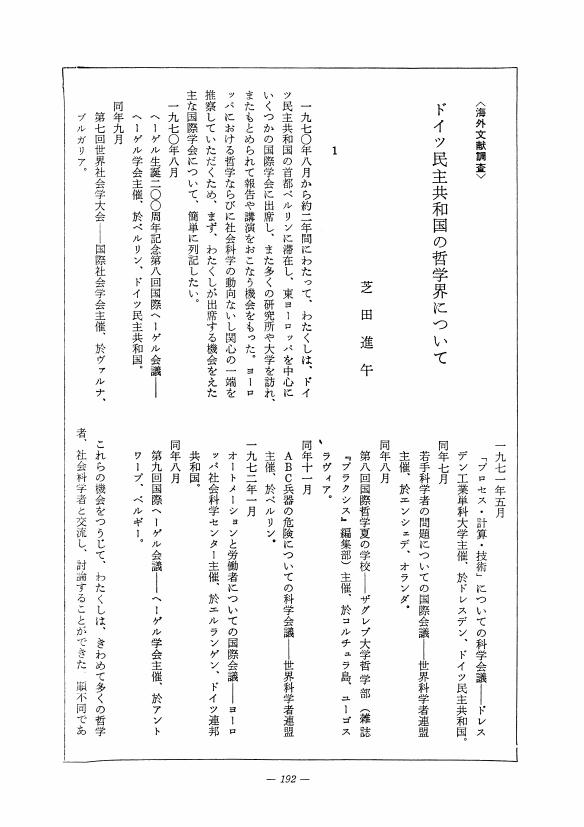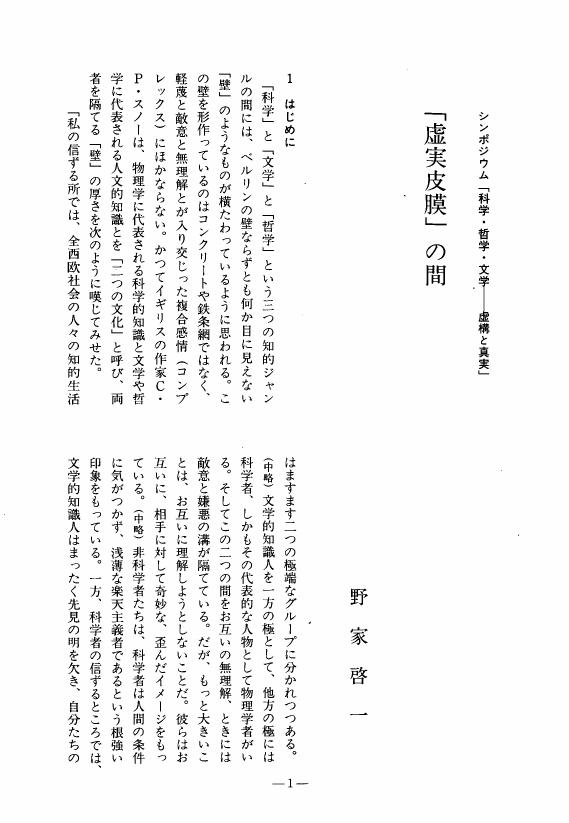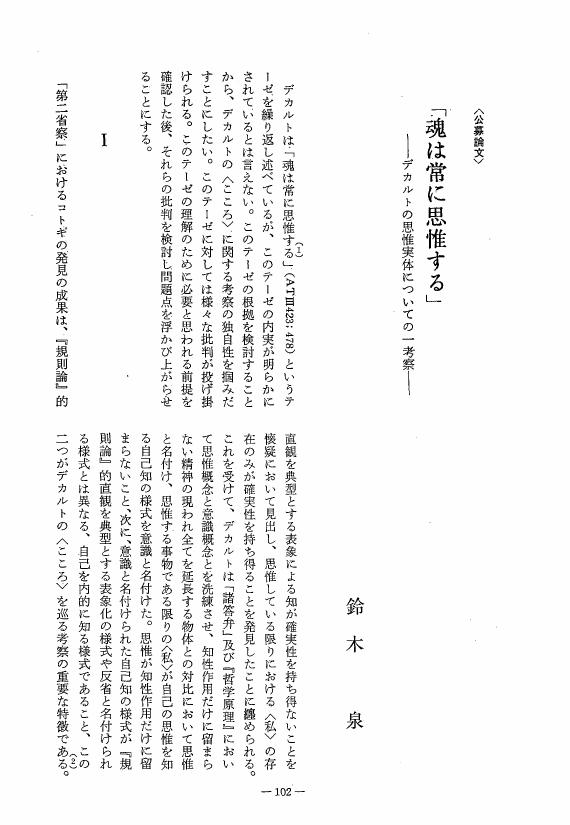1 0 0 0 OA 捻れたイマージュ ベルクソンにおける知覚と存在の錯節をめぐって
- 著者
- 荒谷 大輔
- 出版者
- 日本哲学会
- 雑誌
- 哲学 (ISSN:03873358)
- 巻号頁・発行日
- vol.2004, no.55, pp.115-129,24, 2004-04-01 (Released:2009-07-23)
La notion de l'image bergsonienne est complexe. Il a introduit cette notion en disant:«l'esprit [qui ignorerait les discussions entre philosopher] croirait naturellement que la matière existe telle qu'il la percoit.» Cependant, malgré la simplicité de cette introduction, sa portée est très large.L'image est percipi dans la conscience.«it n'y a pas de perception qui ne soit imprégnée de souvenir».Afin de percevoire quelque chose, it faut avoir par avance des images dans la conscience. D'autre part, Bergson dit en même temps:«une image peut etre sans être percue ».«il n'y a pas une image inextensive qui se formerait dans la conscience et se projetterait ensuite en P». Mais quel est le statut d'une telle image conservée dans la conscience bien qu'elle en existe indépendamment? Sur ce point, le rapport entre l'esse et le percipi de l'image devient compliqué.Pour résoudre cette complication, Bergson dit« il y a pour les images une simple différence de degré, et non pas de nature, entre être et être consciemment percues. »Ainsi la cohérence de la philosophie bergsonienne est gardée provisoirement. En admettant que cette conception soit possible dans son système, est-elle toujours valable en réalité? Il serait difficile d'y croire pour« L'esprit qui ignorerait les discussions entre philosophes ».Dans cet article, nous aimerions mettre en question la détermination de ce concept bergsonien de l'image et constater sa validité. De cette facon, nous trouverons le point d'intersection de l'épistémologie (percipi) et de l'ontologie (esse) dans le discours de Bergson.
1 0 0 0 OA J・ロイスの絶対的プラグマティズム カントとプラグマティズムを考える
- 著者
- 石田 正人
- 出版者
- 日本哲学会
- 雑誌
- 哲学 (ISSN:03873358)
- 巻号頁・発行日
- vol.2003, no.54, pp.142-153,237, 2003-04-01 (Released:2009-07-23)
Royce's place in the history of American thought is unique. His philosophy is a synthesis of absolutism and a voluntaristic type of pragmatism. It is important to bear in mind, however, that Kant always remained influential in his thought. Thus the core of Royce's absolute pragmatism exhibits a version of apriorism with a constructive epistemology.His epistemology in turn extends further to comprehending his theory of reality, by which he intends to supplement Kant's philosophy with a new ontological framework. This is what he calls the "Fourth Conception of Being." It states that his approach to reality depends not on the fact that the world is mental, but on insisting that the being of the world consists in the truth of the propositions about it. In this regard his view is opposed to metaphysical realism, and to traditional idealism as well, which takes the world to be mental.Despite the modern rebellion against such a form of thought, Royce's philosophy still seems to represent an important part of the pragmatistic-idealistic heritage of western thought. The present paper tries to appreciate some aspects of this heritage and to show the close connection between pragmatism and the broadly Kantian approach to truth and reality.
1 0 0 0 OA アリストテレスの本質論における「それぞれのもの」
- 著者
- 岩田 圭一
- 出版者
- 日本哲学会
- 雑誌
- 哲学 (ISSN:03873358)
- 巻号頁・発行日
- vol.2003, no.54, pp.154-166,236, 2003-04-01 (Released:2009-07-23)
The aim of this paper is to clarify what the word hekaston signifies in Aristotle's theory of essence, as it is developed in his Metaphysics Z4-6 and 10-12. In Z4, Aristotle refers to "you, " an individual substance, as an example of hekaston, in order to explain the essence of hekaston. However, if we interpret the word hekaston to signify individual substance, it becomes difficult to understand the claim in Z6 that hekaston is to be identified with its essence. For the individual substance has essence as its essential aspect and accidents as its non-essential aspects. The alternative interpretation is that the word hekaston signifies form. But this interpretation is not appropriate to the context of Z4-6, where Aristotle does not take hylomorphism into consideration. So I suggest a third interpretation, according to which the word hekaston signifies an individual substance that is tentatively treated as that which has no accident. The advantage of this interpretation is that the word signifies such an individual substance throughout Z4-6. Furthermore, this interpretation helps us to understand the difference between the viewpoint of the first half of the theory of essence and that of the latter half.
1 0 0 0 OA 事物統覚の形成基盤 二つの動機づけの観点から
- 著者
- 宇多 浩
- 出版者
- 日本哲学会
- 雑誌
- 哲学 (ISSN:03873358)
- 巻号頁・発行日
- vol.2003, no.54, pp.167-179,235, 2003-04-01 (Released:2009-07-23)
In der Phänomenologie Husserls ist die Dingapperzeption das System von intentionalen Strahlen, das üiber das eigentlich Gegebene hinaus auf den Horizont uneigentlich gegebener Erscheinungen verweist. In dieser Abhandlung versuche ich die Grundlage dieser Dingapperzeption freizulegen. Zu diesem Zweck soll der Begriff Motivation eine wichtige Rolle spielen.Zunächst ist die Dingapperzeption als ein System von Erwartungsintentionen von der assoziativen Motivation bestimmt. Die impressional gegebenen Daten fließen in die Vergangenheiten ab und werden doch retentional behalten. Wenn ein neues Moment ähnlichen Inhalts gegeben ist, dann weckt es assoziativ diese Vergangenheiten, und diese, sich in die Zukunft projizierend, motivieren die Erwartungen gleichen Stiles. In dieser Weise ist die Dingapperzeption als ein System von Erwartungen assoziativ ausgebildet.Dadurch ist aber die fundamentale Schicht der Apperzeption noch nicht freigelegt. Denn sie ist in ihrem Fundament durch Kinästhese motiviert. Kinästhese ist das System meiner Bewegungsempfindungen, meiner Bewegungsmöglichkeiten. Diesem System entspricht ein Horizont moglicher Erscheinungsreihen in meiner Wahrnehmung. Hier steht ein inniger Motivationszusammenhang zwischen dem kinästhetischen System und dem Horizont möglicher Erscheinungen. Die Dingapperzeption, die auf den Gesamthorizont möglicher Erscheinungen verweist, ist also ursprünglich durch diese kinästhetische Motivation bestimmt. Erst durch die Zusammenarbeit beider Motivationen, der kinästhetischen und assoziativen, kann sie ein einheitliches System von intentionalen Strahlen ausbilden.
1 0 0 0 OA 固有名の指示とコミュニケーションの連鎖
- 著者
- 大石 敏広
- 出版者
- 日本哲学会
- 雑誌
- 哲学 (ISSN:03873358)
- 巻号頁・発行日
- vol.2003, no.54, pp.180-191,234, 2003-04-01 (Released:2009-07-23)
What we are concerned with is the question of how we can refer to something with a proper name. Descriptive theorists believe a description to be an essential factor. Causal theorists claim that a community plays a leading role. In this paper I have showed three points. First, against the causal theory, a parasitic description is essentially related to the reference of a name. A parasitic description is a description that includes a reference to another's reference to the particular in question. When we intend to refer to something with a proper name, we must be ready to show a parasitic description as a minimum condition. Secondly, when we use a proper name, we postulate that the proper name has been successfully passed down from link to link in a community, and we are on the far end of this chain of communication. Thirdly, for the time being, the fact that we have a parasitic description shows that we are on this far end of the chain of communication. From these three points we can derive the argument that it is beside the point to ask the question whether the major factor in determining the reference of a proper name is a description or a chain of communication. The conflict between the descriptivist theory and the causal theory is superficial.
1 0 0 0 OA 記号と「未開」世界 ハイデガーの実存論的分析論における記号の問題
- 著者
- 加藤 恵介
- 出版者
- 日本哲学会
- 雑誌
- 哲学 (ISSN:03873358)
- 巻号頁・発行日
- vol.2003, no.54, pp.192-203,234, 2003-04-01 (Released:2009-07-23)
In "Sein und Zeit" ist das Zeichen nur als eine Art des Zeugs bestimmt. Dabei ist die Sprache nicht im Zeichen eingeschlossen. Nach Heidegger hat das Zeichen keine andere ontologische Struktur als die des Zeugs überhaupt.Aber das Zeichen hat die Eigentümlichkeit, daß es nicht nur andere Dinge zeigt, sondern es auch die ontologische Struktur der Weltlichkeit anzeigt. Bei all dem bestimmt Heidegger das Zeichen nur als eine Art des Zeugs, weil er nach der griechischen Überlieferung die nächsten dem Menschen begegnenden Dinge als Zeug bestimmt.Auf der anderen Seite ist seiner Ansicht nach in der "primitiven Welt" das Zeichen noch nicht als Zeug gefunden. Dies macht eine wesentliche Differenz zwischen den ontologischen Strukturen der "unseren" Welt and der "primitiven" Welt aus. Dann bedarf es der formalen Idee von Weltlichkeit, die beiden Welten gemeinsam ist, und diese Idee wäre nicht der Zusammenhang des Zeuges, sondern der Zusammenhang des Zeichens, den Heidegger vermeidet. Dies veranlaßt uns, zu fragen, welche Voraussetzungen der existenzialen Analytik des Daseins bei Heidegger zu Grunde liegen.
1 0 0 0 OA トマス・アクィナスにおけるエッセの意味論
- 著者
- 加藤 雅人
- 出版者
- 日本哲学会
- 雑誌
- 哲学 (ISSN:03873358)
- 巻号頁・発行日
- vol.2003, no.54, pp.204-214,233, 2003-04-01 (Released:2009-07-23)
- 参考文献数
- 16
Esse (ens) dupliciter dicitur. What does Aquinas mean by this distinction? T. Veres, who first indicated the fundamental importance of this distinction in the metaphysical thought of Aquinas, interpreted it as eine fundamentale ontologische Dichotomie. On the other hand, H.Weidemann regarded it as two semantically different uses of the verb “be. ” In this paper, I intend to argue against both Veres and Weidemann and attempt a more sophisticated interpretation.The view presented by Veres faces two serious difficulties, which are necessarily caused by his ontological interpretation. Weidemann's semantic explanation of Aquinas' dichotomy of being in accordance with Fregean trichotomy fails because the Fregean distinction of the 'is' of existence, of predication, and of identity doesn't seem to be consistently applicable to Aquinas.I interpret Aquinas' distinction between esse ut actus essendi and esse ut verum from a semantic viewpoint as being the distinction between two aspects of significare, i.e. res significata and significatum. Significare means not only to refer to things (res significata), but also to make conceptions understood (significatum) by expressing them. Thus esse (ens) dupliciter dicitur means, on the one hand, that esse refers to reality, and, on the other, that esse, combining a predicate with a subject as a copula, expresses an affirmative proposition as known to mind and asserts its truth.
1 0 0 0 OA カントの〈直観〉と〈象徴〉をめぐる一考察
- 著者
- 田中 綾乃
- 出版者
- 日本哲学会
- 雑誌
- 哲学 (ISSN:03873358)
- 巻号頁・発行日
- vol.2003, no.54, pp.215-226,232, 2003-04-01 (Released:2009-07-23)
This essay treats of Kant's concept of intuition. Intuition shown as the key subject in Kant's Critique of Pure Reason is mainly sensible intuition.Kant's argument, however, was not understood at that time. Traditionally, intuition meant intellectual intuition. Therefore, conforming to this tradition, Kant's concept of intuition was regarded as a degradation from a high degree of "intellectuality" to a lower degree of "sensibility", which was criticized.But I think the opposite, that is to say, that neither intellectuality nor sensibility is necessarily the property of intuition itself. In this essay, I try to show that the original property of intuition is "immediacy", and examine the case of Kant.In addition, I aim at the idea that the symbol is identified as intuitive cognition in Critique of Judgment, and I try to clarify the important role of intuition in Kant's philosophy.
1 0 0 0 OA ドイツ観念論と現代
- 著者
- 四日谷 敬子
- 出版者
- 日本哲学会
- 雑誌
- 哲学 (ISSN:03873358)
- 巻号頁・発行日
- vol.1987, no.37, pp.77-93, 1987-05-01 (Released:2009-07-23)
- 参考文献数
- 22
1 0 0 0 OA べーメとドイツ哲学
- 著者
- 大村 晴雄
- 出版者
- 日本哲学会
- 雑誌
- 哲学 (ISSN:03873358)
- 巻号頁・発行日
- vol.1965, no.15, pp.142-156, 1965-03-31 (Released:2010-01-20)
- 参考文献数
- 38
J. Böhmes Theosophie ist der sehr charakteristische, christliche Mystizismus und ist ganz anderes als die Philosophie. In der Tat trat sie nicht in die deutsche Philosophie seit Leibniz hinein. Aber, was den deutschen Idealismus betrifft, so hatte sie grossen Einfluss auf Hegel und Schelling. Wenn sie auch hier unverändert, charakteristisch war, so wurde sie doch in geeigneter logischer Form systematisiert und in dem bestimmten Bereich der deutschen Philosophie verallgemeinert. Hegels Konzeption über die “Wissenschaft der Logik” ist insbesondere bemerkenswert. Die spekulative Seite der Böhmeschen Theosophie wurde erst von ihm klar gemacht und erweitert. Schelling war dagegen vielmehr der Nachfolger ihrer mythologischen Hauptseite.
1 0 0 0 OA ドイツ観念論における倫理的共同存在の問題 「相互承認」をめぐって
- 著者
- 高田 純
- 出版者
- 日本哲学会
- 雑誌
- 哲学 (ISSN:03873358)
- 巻号頁・発行日
- vol.1977, no.27, pp.149-159, 1977-05-01 (Released:2009-07-23)
ドイツ観念論倫理学の基本性格は、経験的なものから純化されたアプリオリな理性意志=自由意志をその原理とする点にあるといえよう。カントは、このような理性意志にこそ、万人を結合する道徳法則の根拠、万人の自由な倫理的共同存在にとっての根本原理が求められると考えた。しかし、倫理的共同存在の実現の問題が具体的に問われるためには、カントにおいて捨象されるのに急であった意志主体(人格)相互のあいだの経験的諸規定があらためてとりあげられ、理性意志がどのようにしてこれらをつうじて内在的かつ具体的に確立されるかが把握しかえされなければならないであろう。そしてまた、このような過程をへることによって、理性意志の原理は、経験的なものを外的に規定する形式的原理であることをこえて、経験的なもののなかで作用する生きた内在的形式、活動原理にまで高められることになるであろう。フィヒテを経てヘーゲルに到るドイッ観念論倫理学の歩みは、これらの問題の自覚的追求の過程でもあった。この過程においては、意志相互の具体的な関係と働きかけ(交通)およびその現実的な場としての社会のなかでの意志の理性的形成(理性意志の社会的、間主観的基礎づけ)の問題が論究されるとともに、逆にまた、現実社会がこのような理性意志の実現として理性化、倫理化 (社会の理性的基礎づけ) される方向へと進んでいく。本稿では、ドイツ観念論におけるこのような推移を、とくに、そのさいの考察の結節点としての位置にあると思われる「相互承認Gegenseitiges Anerkennen」概念に着目しつつ、またこの概念を自覚的にとりあげた初期フィヒテとヘーゲルを重点に、概観してみたいと思う。
1 0 0 0 OA ドイツ民主共和国の哲学界について
- 著者
- 芝田 進午
- 出版者
- 日本哲学会
- 雑誌
- 哲学 (ISSN:03873358)
- 巻号頁・発行日
- vol.1973, no.23, pp.192-200, 1973-05-01 (Released:2009-07-23)
- 参考文献数
- 9
- 著者
- 渡辺 二郎
- 出版者
- 日本哲学会
- 雑誌
- 哲学 (ISSN:03873358)
- 巻号頁・発行日
- vol.1980, no.30, pp.1-28, 1980-05-01 (Released:2009-07-23)
1 0 0 0 OA 制度と社会についての基礎理論・序説
- 著者
- 中村 雄二郎
- 出版者
- 日本哲学会
- 雑誌
- 哲学 (ISSN:03873358)
- 巻号頁・発行日
- vol.1967, no.17, pp.115-139, 1967-03-31 (Released:2009-07-23)
- 参考文献数
- 23
1 0 0 0 OA フッサールの論理学観 形式主義批判を中心として
- 著者
- 高橋 哲哉
- 出版者
- 日本哲学会
- 雑誌
- 哲学 (ISSN:03873358)
- 巻号頁・発行日
- vol.1982, no.32, pp.160-169, 1982-05-01 (Released:2009-07-23)
フッサール現象学の生誕の書が『論理学研究』であったことはよく知られていよう。現象学はまず何よりも、学問論 (Wissenschaftslehre) としての純粋論理学の理念を闡明し、その実現の端緒を拓こうとするこの書の努力の中で、「論理的なものの現象学 Phanomenologie des Logischen」 (LU.II/8,III) として登場してきたのである。その後、超越論的現象学の理念が確立されると、純粋論理学の基礎づけは課題の緊急性を失ったが、しかしフッサール思想における「論理的なもの」の意義は決して減ずることがなかった。というのも、フッサールは結局、「形式論理学」を「形式的学問論」として、「実質論理学」を「質料的学問論」として構想しただけでなく、それらに究極の権利を付与すべき超越論的現象学そのものにも、「究極の学問論」としての「超越論的論理学」の機能を認めていたからである (XVII,20,157f.,296)。それ故、フッサール現象学の意義と射程を見定めるためには、それらすべての企ての共通の根である「論理的なもの」、或いは一般にロゴス (Logos) なるものの本質を解明することが不可欠の作業であるが、本稿での我々の課題は、フッサールにおいて「論理的なもの」の理念のいわば母胎となった形式論理学の場面に照準し、そこでフッサールが行なった形式主義批判の内実を検討することによって、その作業の一端に寄与しようとすることである。
- 著者
- 門屋 環
- 出版者
- 日本哲学会
- 雑誌
- 哲学 (ISSN:03873358)
- 巻号頁・発行日
- vol.1969, no.19, pp.251-262, 1969-03-31 (Released:2009-07-23)
- 参考文献数
- 20
Adam Smith believed that England in 18 century increased to social power of production by robust self-loved mind in social instinct.Smith insisted the individual's social instinct to continued public welfare by moral sentiment above to religious sentiment, and realized the world of religious capitalism his expected.
1 0 0 0 OA ドゥンス・スコトゥスの形相的区別について 意味論的観点から
- 著者
- 本間 裕之
- 出版者
- 日本哲学会
- 雑誌
- 哲学 (ISSN:03873358)
- 巻号頁・発行日
- vol.2019, no.70, pp.250-265, 2019-04-01 (Released:2019-04-18)
Almost all interpreters agree that the formal distinction (distinctio formalis) of Duns Scotus is located between formalities/entities/realities. This concept is characterized as a “mediate distinction” between the real distinction (distinctio realis), which exists without intellect, and the distinction of reason (distinctio rationis), which is produced only by the activity of the intellect. According to Scotus, the formal distinction has both a real basis and a relationship to intellect. These characterizations do not provide a complete exposition of formal distinction; rather, they raise questions about the nature of formality: what is its ontological status, and how formal distinction relates to intellect. Major interpreters, such as Maurice Grajewski, Allan Wolter, and Michel Jordan, have not provided clear answers to these questions. The main purpose of the present article is to respond to these questions by describing the system of formal distinction in the thought of Scotus. First, we consider Scotus’s motivation to introduce this distinction by analyzing his answer to the question “Whether this proposition ‘man is animal’ is true?” His aim in this question of his Quaestiones in librum Porphyrii Isagoge, if we adopt the language of current analytical philosophy, is to put forward a truthmaker theory. And this interpretation is further elucidated in his (probably) late work, Quaestiones super libros Metaphysicorum Aristotelis. Second, depending on this understanding, we describe formal distinction using the mathematical idea of homomorphism. In Scotus’s thinking, the homomorphic map φ, which preserves the structure of propositions, can be possibly defined as follows: φ: C → M (where C is the logical or intentional domain and M is the metaphysical or existential one). We call this map φ the analytical map. This mathematical model suggests a distinct formulation of formal distinction. Let c, c1, and c2 be concepts, R1 and R2 be relations between concepts, f, f1, and f2 be formalities, and R1′ and R2′ be relations between formalities. There then exists an analytical mapping such that φ(cR1c1) = fR1 ′f1 and φ(cR2c2)= fR2′ f2; the distinction, then, between f1 and f2 is a formal distinction. This interpretation provides a foundation for Wolter’s idea that formality is an objective basis for a concept produced by intellect.
1 0 0 0 OA 「虚実皮膜」の間
- 著者
- 野家 啓一
- 出版者
- 日本哲学会
- 雑誌
- 哲学 (ISSN:03873358)
- 巻号頁・発行日
- vol.1990, no.40, pp.1-18, 1990-04-01 (Released:2009-07-23)
1 0 0 0 OA 道徳的価値の規範性 構成主義に基づく一解釈
- 著者
- 福間 聡
- 出版者
- 日本哲学会
- 雑誌
- 哲学 (ISSN:03873358)
- 巻号頁・発行日
- vol.2008, no.59, pp.293-308,L22, 2008-04-01 (Released:2010-07-01)
- 参考文献数
- 15
Constructivism can usefully be seen as a view about normativity. It denies both that normativity is a constraint based on a fact which is prior to and independent of our stance (realism), and also that it is a merely causation originating in our conative attitudes (noncognitivism). It takes normativity to be a requirement which is derived from our rational choices and which is constructed by our practical reason. On this constructivist view, it becomes clear that normativity is constitutive of those who ‘are agents who make choices and judgments on the basis of reasons’. In this article, by examining moral judgments about the good from the viewpoint of Korsgaard's constructivism, I consider how it explains the normativity of moral value, and how it presents a possible means of dissolving the controversy between realism and non-cognitivism about moral value. First of all, I clearly specify what it is to be constructivist (sec. 2). Secondly, through examining a constructivist criticism of realism (sec. 3-4) and the rationalist theory about the good which constructivism advocates (sec. 5), I show that an important feature of the constructivist account of the normativity of moral value is that it emphasizes the procedure of making moral judgments in the light of our multiple agency. Thirdly, I set out what it is to be a reason-a concept which constructivism presupposes (sec. 6). Lastly, I reply to some objections to constructivism (sec. 7). In this article, I particularly take up G. E. Moore's realism and investigate onstructivism's explanation of normativity by contrast with this.
1 0 0 0 OA 「魂は常に思惟する」 デカルトの思惟実体についての一考察
- 著者
- 鈴木 泉
- 出版者
- 日本哲学会
- 雑誌
- 哲学 (ISSN:03873358)
- 巻号頁・発行日
- vol.1991, no.41, pp.102-112, 1991-04-01 (Released:2009-07-23)





